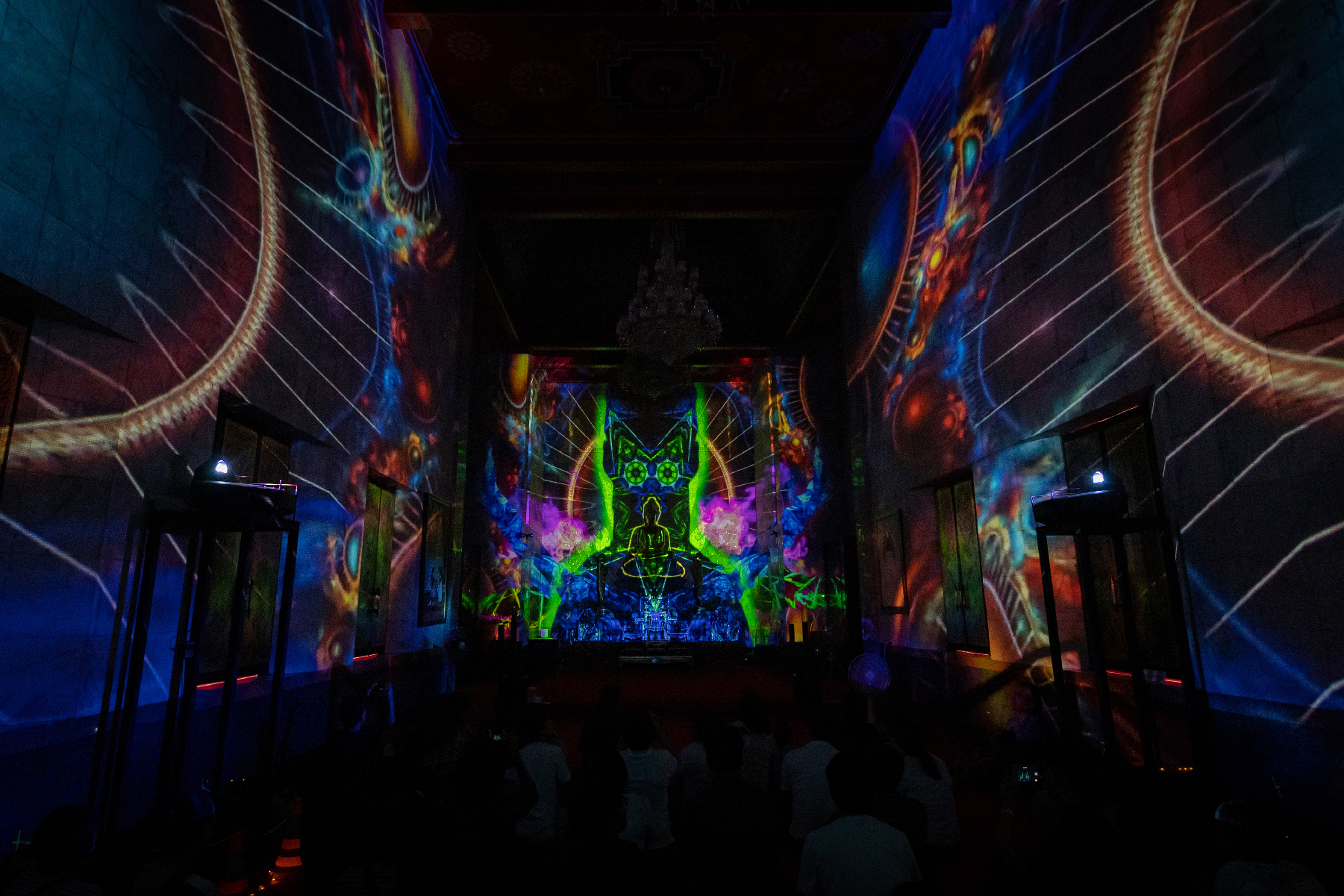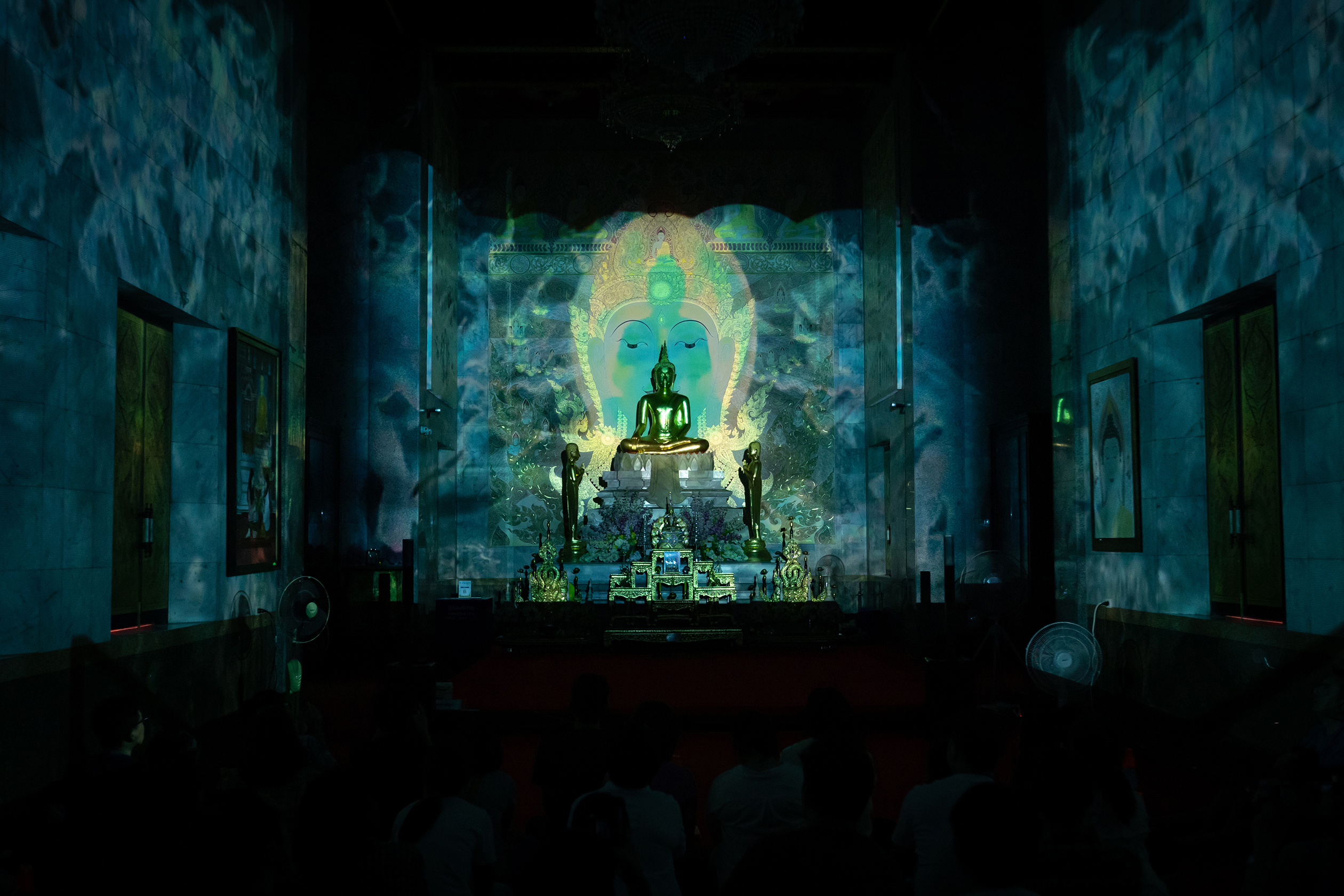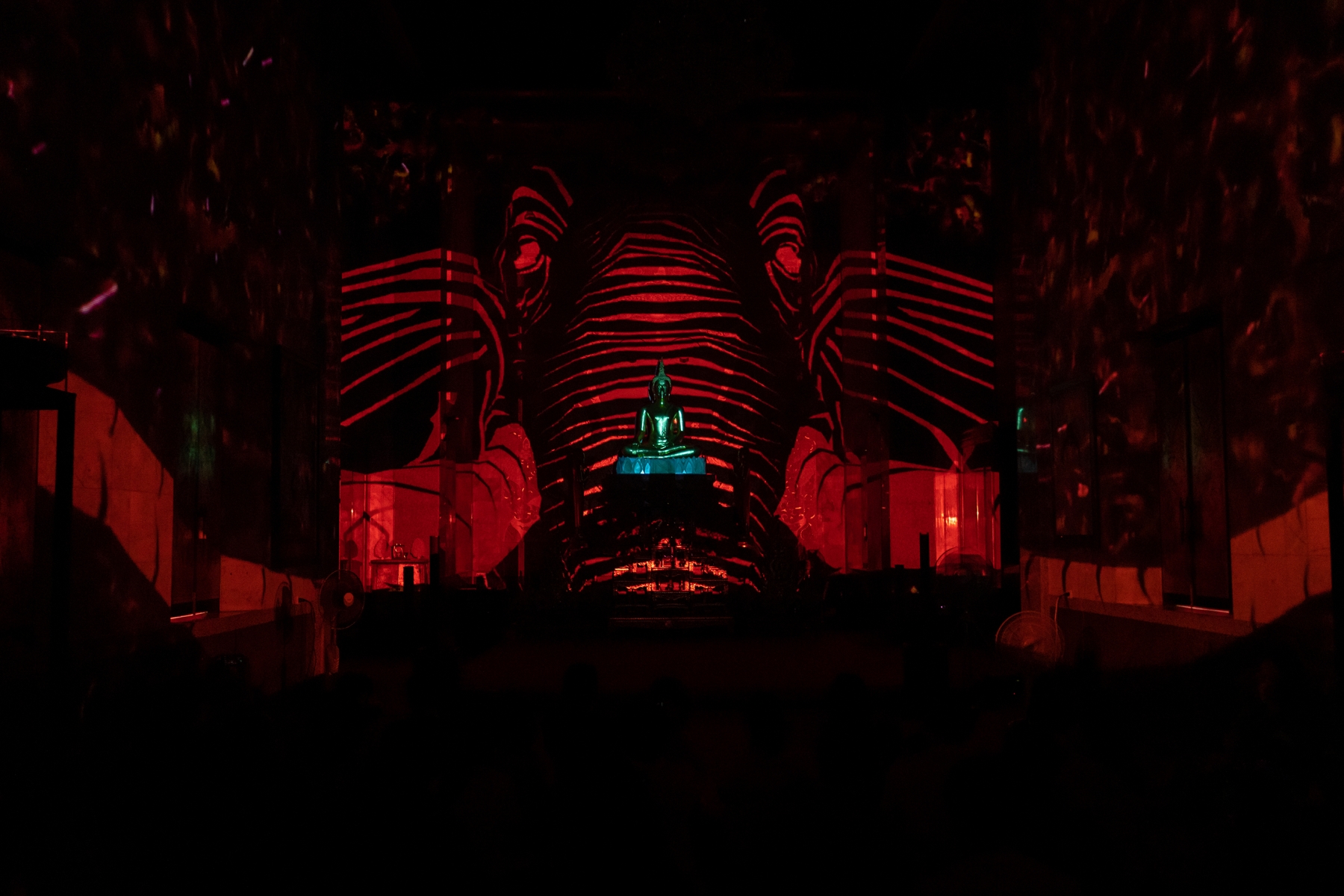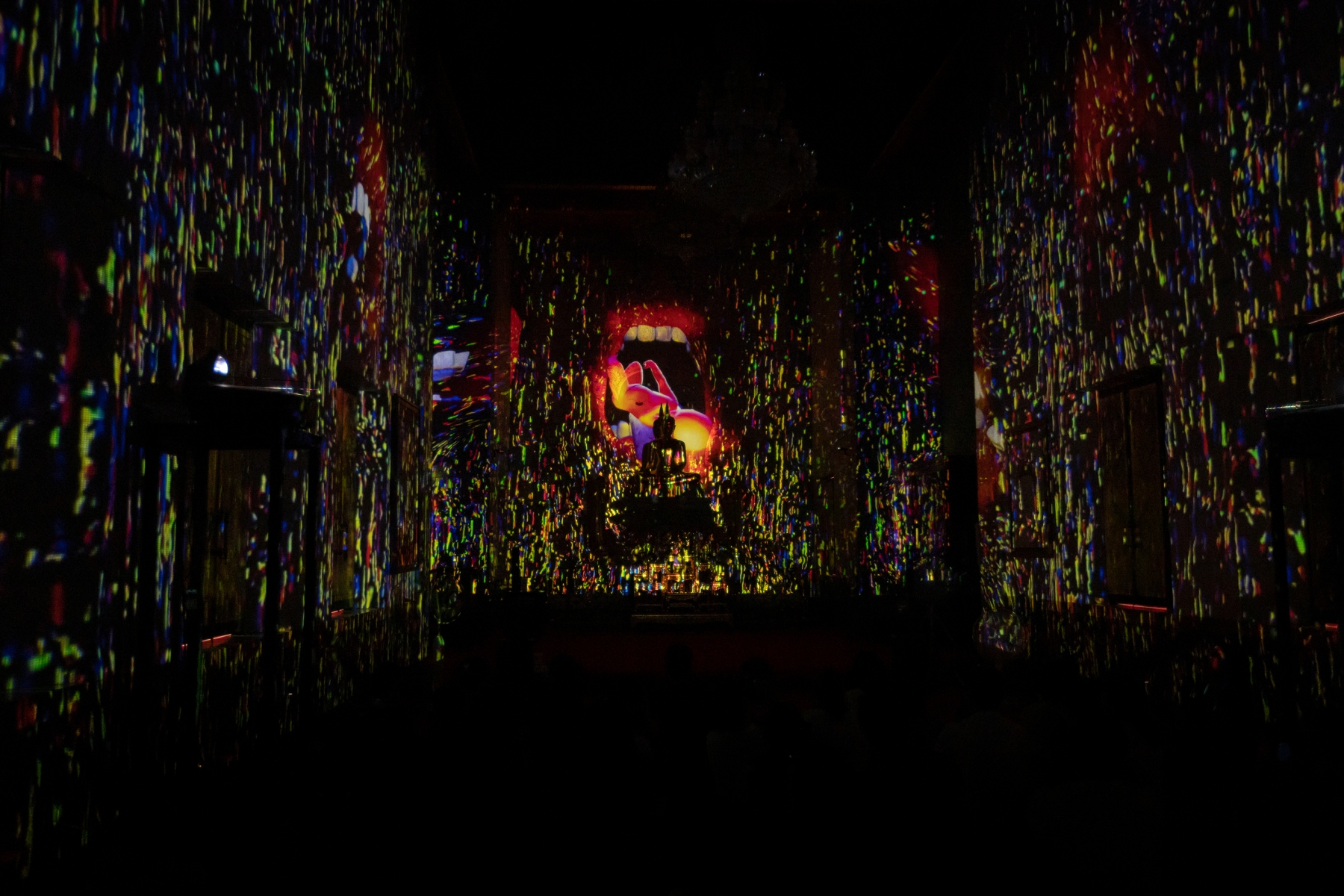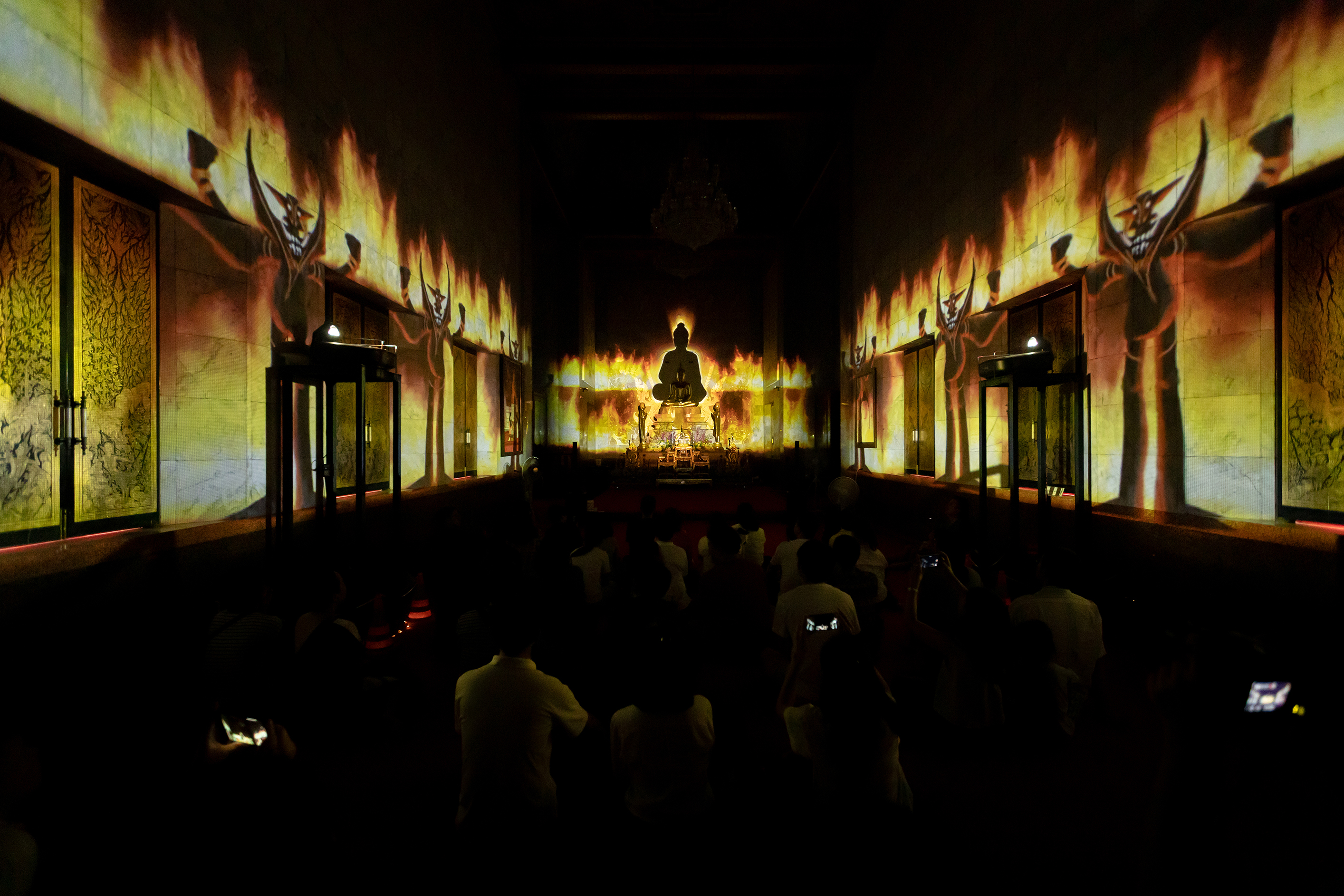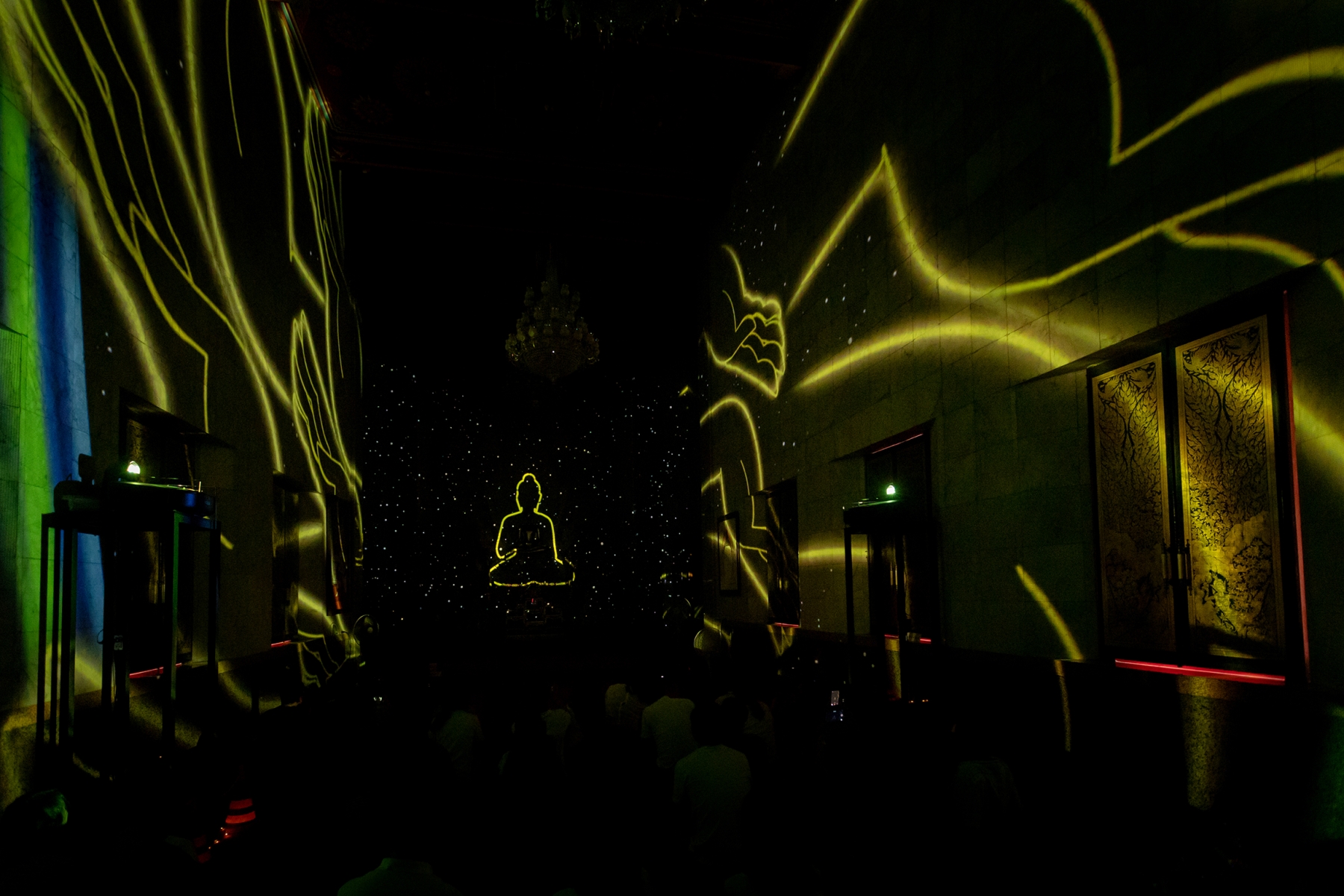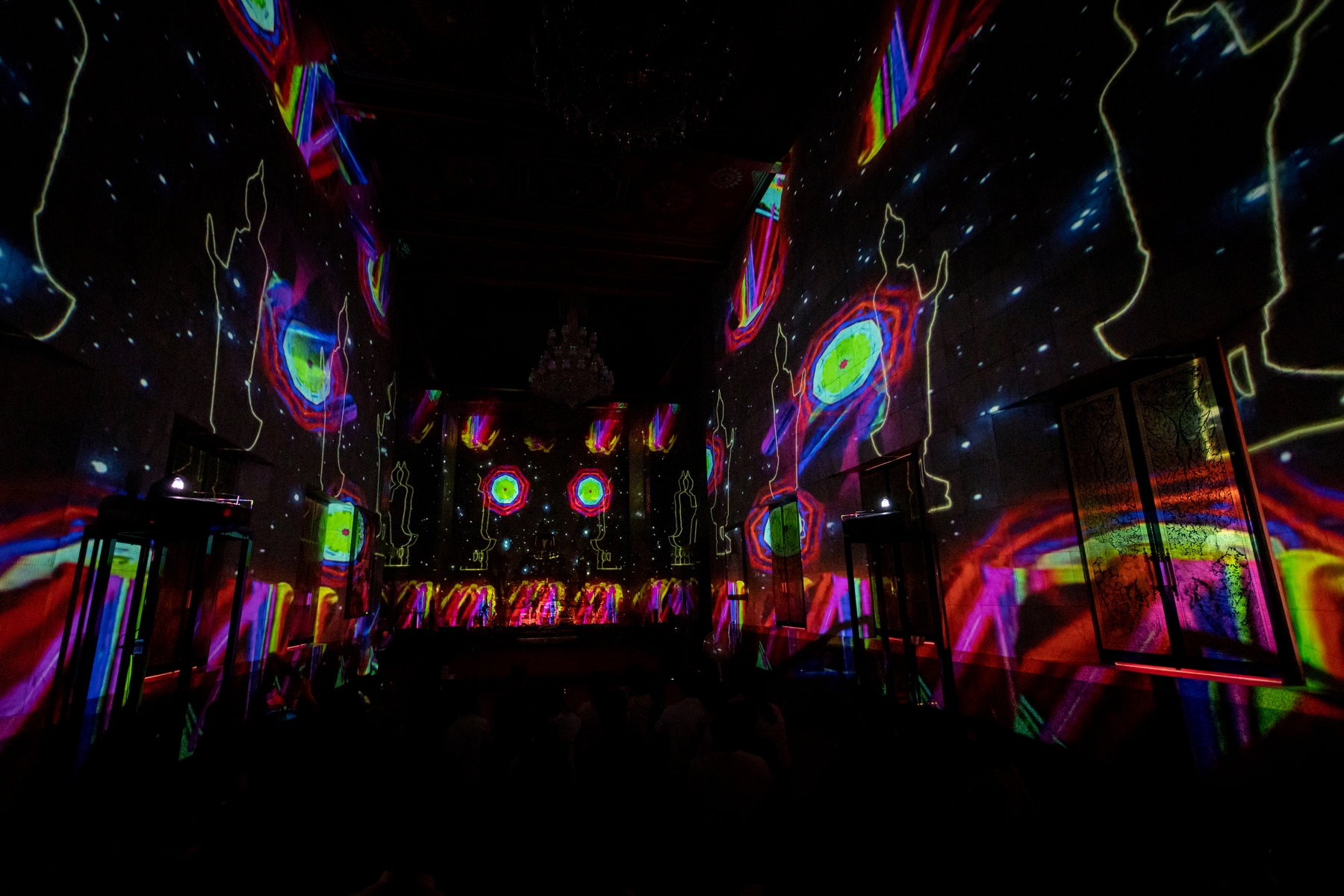WE HAVE SOME GOOD NEWS FOR YOUNGSTERS, THE BUDDHIST DOCTRINE IS NO LONGER BORING SINCE THE BLOOM OF THE RECENT SHOW OF BODHI THEATER
TEXT: SUTEE NAKARAKORNKUL
PHOTO: KETSIREE WONGWAN
(For English, please scroll down)
งานศิลปะร่วมสมัยภายในวัดไม่ใช่เรื่องที่แปลกใหม่แต่อย่างใด เมื่อปีที่ผ่านมา Bangkok Art Biennale ได้นำผลงานศิลปะหลายชิ้นเข้าไปติดตั้งในพื้นที่วัดหลวงของกรุงเทพฯ ถึงสามวัดด้วยกัน (วัดอรุณฯ วัดโพธิ์ และวัดประยุรวงศาวาสวรวิหาร) ดังนั้นความน่าสนใจของ “โพธิเธียเตอร์: แก่นเดิม เปลือกใหม่ ของพุทธศาสน์” (Bodhi Theater – Buddhist Prayer, Re-told) นิทรรศการศิลปะดิจิตอลที่จัดขึ้นเป็นครั้งแรกภายในเขตพุทธาวาสชั้นในอย่างพระอุโบสถของวัดสุทธิวราราม ก็อาจจะไม่ได้อยู่ที่ว่ามันเป็นสิ่งที่ไม่เคยเกิดขึ้นมาก่อน แต่คงเป็นเพราะความอยากรู้ว่าการเปลี่ยนพื้นที่พระอุโบสถให้กลายเป็นโรงหนังที่เต็มไปด้วย แสง สี เสียง จะออกมาเป็นอย่างไรมากกว่า
โปรเจ็คต์นี้มีที่มาจากคำถามว่าจะทำอย่างไรให้วัดและคำสอนของพุทธศาสนาแมทช์กับไลฟ์สไตล์ของคนเมืองมากขึ้น ในยุคที่เหมือนว่าคนจะโอนเอียงเข้าหาเทคโนโลยีมากกว่าศาสนา จนนำมาสู่การร่วมมือกันระหว่างศิลปินและนักออกแบบที่เคยมีประสบการณ์ทำงานร่วมกันในนิทรรศการ “กลับตาลปัตร” (ที่นำตาลปัตรของพระสงฆ์มาตีความใหม่) นำโดย project manager ธวัชชัย แสงธรรมชัย จากเอเจนซี่ WHY NOT Social Enterprise ปานปอง วงศ์สิรสวัสดิ์ design director และสารัตถะ จึงเสถียรทรัพย์ animator จาก Another Day Another Render กนต์ธร เตโชฬาร character designer โดยมีก่อเกียรติ ชาติประเสริฐ รับหน้าที่เป็น sound designer ภายใต้โจทย์หลักในการทำงานก็คือ จะนำเสนออย่างไรโดยไม่ไปเปลี่ยนแก่นหลักของคำสอน
ทีมผู้จัดงานนำเทคโนโลยี Projection Mapping หรือการฉายภาพเคลื่อนไหวลงบนวัตถุและผนังอาคารมาใช้เป็นสื่อหลักของโชว์ชุดนี้โดยหยิบเอา “พุทธชัยมงคลคาถา” (พาหุงมหากา) บทสรรเสริญชัยชนะของพระพุทธเจ้าเหนือมารผจญ รวมทั้งหมด 8 ตอน มาตีความเสียใหม่ พร้อมกับเปลี่ยนบทสวดภาษาบาลีให้กลายเป็นซาวด์ดนตรีบีทหนักๆ (เกือบๆ EDM) และแอนิเมชั่นตัวละครสีจัดๆ ชวนตื่นตาตื่นใจ
โชว์เริ่มต้นขึ้น พระอุโบสถมืดสนิท เมื่อนั้นเองที่ผนังทั้ง 3 ด้าน กลายมาเป็นจอให้ตัวละครขนาดมหึมาได้เคลื่อนไหวไปรอบๆ ผู้ชม สิ่งที่เราคิดว่าน่าสนใจคือการคงความสำคัญองค์พระประธานให้ยังคงเป็นจุดรวมสายตาเฉกเช่นเดิม ด้วยการทำให้ผนังฝั่งพระประธานเป็นเหตุการณ์หลัก ส่วนผนังด้านข้างจะเป็นเหตุการณ์ที่กำลังเคลื่อนเข้ามา ฉากสำคัญของโชว์คงจะเป็นตอนที่อาฬวกยักษ์ปัดเศียรพระพุทธรูป เราจะเห็นการ “เล่น” กับความ “นิ่ง” ของพระพุทธรูป เพราะองค์พระประธานในสถานะวัตถุที่ขยับไม่ได้กลับดูเหมือนกำลังเคลื่อนไหว โยกตัวหลบไปมา (จากเทคนิคการฉายแสงลงบนพระประธาน) ฉากนี้เองคล้ายกับเตือนสติของเราอีกครั้งว่าพื้นที่ตรงนี้ไม่ใช่เขตพัทธสีมาที่มีกฎเกณฑ์บางอย่างอีกแล้ว แต่มันคือเหตุการณ์ที่เกิดขึ้นระหว่างโลกสองใบคือโลกทางศาสนากับโลกดิจิตอลที่ merge เข้าหากัน
คงไม่มีใครกล้าบอกว่าปรากฏการณ์ “รอบเต็ม” ทุกรอบการแสดง นั้นเท่ากับว่าวัตถุประสงค์ของโครงการได้สัมฤทธิ์ผลไปเป็นที่เรียบร้อยแล้ว แต่อย่างน้อยที่สุด การเกิดขึ้นของนิทรรศการนี้ก็ช่วยทำให้เราเห็นความเป็นไปได้ใหม่ๆ อยู่หลายข้อ หนึ่งคือมันอาจจะทำให้เราสามารถมองศาสนาว่าเป็น “เรื่องเล่า” ชุดหนึ่ง ที่สามารถเอามารีเมคในวิธีการใหม่ๆ ได้ไม่จบสิ้น ส่วนข้อที่สองก็คือ มันอาจจะกลายมาเป็นการตลาดแบบใหม่ของวัดในการดึงเด็กรุ่นใหม่เข้าวัด และกลายเป็นว่าดีไซเนอร์ / ศิลปิน คงจะได้เข้าไปทำงานในวัดกันมากขึ้นในอนาคตอันใกล้
โพธิเธียเตอร์ จัดแสดงระหว่างวันที่ 18 พฤษภาคม – 23 มิถุนายน 2562 ที่วัดสุทธิวราราม

The presence of Contemporary art in religious spaces is nothing new. Last year, as a part of Bangkok Art Biennale, a number of artworks were installed in three different royal temples in Bangkok. Bodhi Theater: Buddhist Prayer, Re-told, the first digital art exhibition held for the first time inside Wat Suthi Wararam Temple’s ordination hall may not be interesting for its originality but it’s more about the curiosity of how the religious space could be transformed into a theatre of lights, colors and sounds.
The project is inspired by the question of how to match religious teachings to urban lifestyle in a time where people are more drawn to technology rather than religion. The idea leads to the collaboration between artists and designers who used to work together in the exhibition ‘Flip the Fan’ (the reinterpretation of talipot, a fan used in Buddhist ceremonies by Buddhist monks). For this particular project, the main challenge was to execute the presentation without deviating the core teachings, Tawatchai Saengthammachai of WHY NOT Social Enterprise took the part of the project manager and joined forces with Panpong Wongsirasawad, designer director and Saratta Chuengsatiansup, animator of Another Day Another Render, character designer, Konthorn Taecholarn and sound designer, Korky Chartprasert.
The team employed projection mapping as the key medium of the show. The 8 episodes of Buddha Jayamangala Gatha, the prayer chanted to express appreciation for the Buddha’s fight against the devils are reinterpreted with the mix of the sound from Balinese prayers, to intense musical beats (almost at the level of EDM) and super colorful and visually striking animation characters.
The show started and the hall went pitch black. The three walls became the screen for the towering sized characters that moved around the audience. What we found to be especially interesting was the way the wall behind the temple’s principle Buddha statue was treated as the main focal point. This particular wall functioned as the screen where the main storyline was projected while the ensuing sequences of the story were screened on two other walls, on the side. The most important scene of the show was when Alawaka Giants was trying to destroy the head of the Buddha statue as viewers witnessed the way the show played with the motionlessness of the statue by making it appear as if it was moving, ducking its head to avoid the attack (the visual movements were achieved through the use of projected lighting). It is with this very scene that viewers were reminded that this space is no longer a realm where rules and restrictions apply, but a place where the two worlds overlap; the religious world and the digital world has merged.
No one dares to say that the ‘sold out’ status on every date of the show could really be considered as the ultimate proof of the project’s objective being achieved. But at the very least, the birth of the exhibition does envision several new possibilities. One of them is that we are now able to view religion as a set of narratives that can be remade and retold using different methods and mediums. The other thing is the tendency for this to be a new marketing strategy that modern-day temples can use to attract the interest of young generation disciples. Last but not least, it is very likely that we will be seeing more collaborations between designers, artists and Buddhist temples in the near future.
Bodhi Theater was held between 18th May and 23rd June 2019 at Wat Suthi Wararam Temple.

